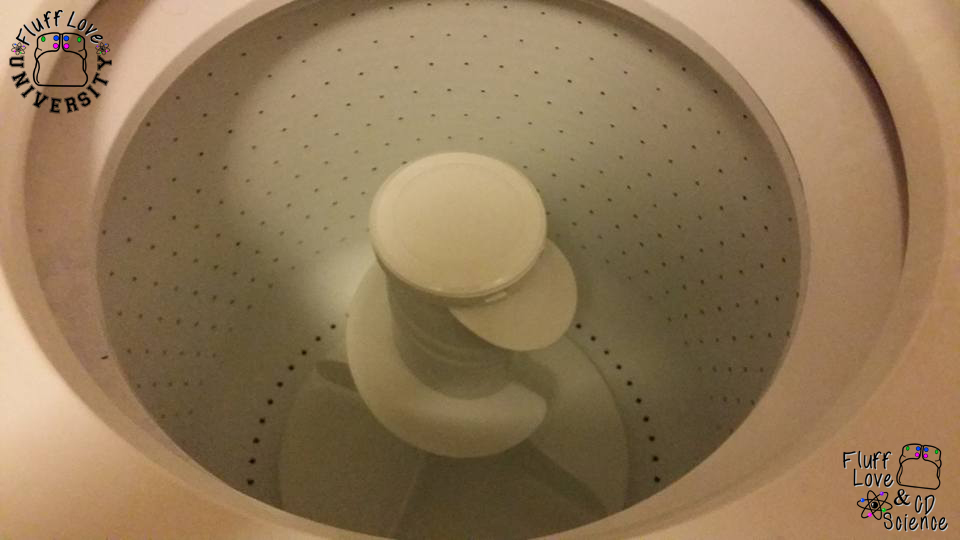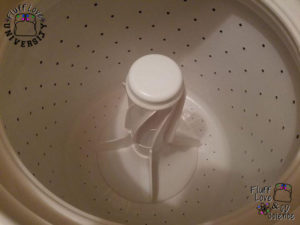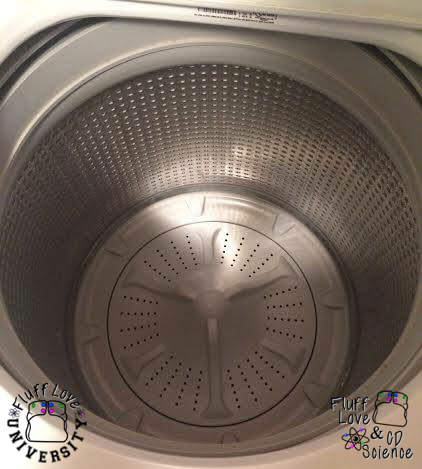Introduction
Many members of Fluff Love & CD Science love their trusty standard washers for the shorter wash times, the agitation provided by an agitator tower and the wider variety of detergents available when not restricted to low-sudsing detergents. Washing in a standard, non-HE washer is easy when you know how to check for the proper ratio of water to laundry.
Choosing a Detergent
Almost any mainstream detergent without fabric softener is just fine for cloth diapers. Often you can use the same detergent you use for your regular laundry – no need to buy special, expensive, “cloth safe” detergents. Ironically, many detergents marketed as “cloth safe” are often too weak to effectively clean diapers. Remember that cloth diapers are the dirtiest laundry you’ll ever wash, so you will need at least as much detergent as you use in your regular laundry, if not more. Be aware that some brands of standard washers, such as Speed Queen, recommend HE detergents, as do many models of hybrid washers that allow you to set load size. Always consult your owner’s manual to make sure you protect your washer and don’t void any warranties. Check out our extensive detergent index to choose a detergent that meets your needs and budget.
Properly cleaning your cloth diapers is simple and easy! It’s all about ratios – the right amount of water, diapers and detergent! Properly cleaned diapers will never smell after washing, will not repel liquids, and will not cause rashes or burns on your baby. If you find yourself needing to strip or bleach your diapers due to any of these issues, it is an indicator that they are not properly cleaned and you need to change your wash routine. Properly cleaned diapers will not require stripping or bleaching.
General Washing Instructions
The Details
Load Size and Consistency
There are several styles of agitators. The style of agitator in your machine determines the load size recommended for optimal agitation and cleaning. Over or under loading can cause reduced agitation, resulting in unclean diapers, as well as excess suds. Remember, suds in general are not a bad thing! But, too many suds are only good for a foam party, not for getting diapers clean. Be sure to check out our Suds and Bubbles page for more information! With the proper ratio of diapers to laundry, the agitator is able to move the diapers throughout the drum, allowing them to scrub together and fully clean the layers of the fabrics. Too much water and not enough fabric means diapers slide by each other without the benefits of a good scrub. Not enough water and too much fabric means diapers are pinned against each other and again not able to get good scrubbing action.
A properly functioning agitator should not damage laundry. If you find that your agitator is snagging or tearing your diapers or other laundry, carefully (don’t cut yourself!) check the inside of the drum for sharp objects. If you’re not able to find the source, talk to a professional.
Spiral Agitators
-
Spiral agitators are one common style of agitator in a standard machine. Spiral agitators usually have small paddles on the bottom, and spirals that run up around the agitator tower. The agitator and the drum move and work together to rotate the diapers and laundry throughout the drum, from top to bottom.

Spiral agitators do best with a larger load size (medium or larger), so if you have one you may need to add other laundry to complete the load. We recommend that you add only items that are the size of a flat diaper or receiving blanket, or smaller, as larger items can wrap around the diapers and keep them from agitating freely throughout the drum.
With a spiral agitator, your water to fabric ratio should look something like “stew.” We want something between soup and chili to ensure you get that ever-important scrubbing action!
To check for stew in a standard washer with a spiral agitator, fill your washer with water and laundry. Check for stew with the washer paused or off, NEVER check with the agitator running! We don’t want anyone to lose a hand! You don’t need the machine to be agitating to check for stew, but you do need to be able to open the lid. Please do NOT trick your washer to run with the lid open. Pausing the cycle and opening the lid when it unlocks is all you need to do.
Once the washer is filled, press down gently with your palm, or a wide-bottomed object such as a potato masher, Mason jar, or rigid water bottle. Press until you just feel resistance, then stop. At that point there should be 3-4 inches of water floating on the top of the diapers. If you have less than 3-4 inches of water on top, you have “chili.” There is too much laundry in the load for the amount of water. Increase the load size if you can, or take out some laundry. If there is more than 3-4 inches of water on top, your load is too “soupy.” Add more laundry, but do not reduce your load size to less than medium.
Keep in mind that “stew” only applies to non-HE machines. If you have an HE washing machine, please see our page on washing in an HE machine.
-
Cloth Diaper Soup Example
-
Cloth Diaper Stew Example
-
Cloth Diaper Chili Example
How to Check for Stew Consistency
Paddle Agitators
- Paddle agitators are another common style of agitator. Paddle agitators do not have the spirals around the agitator tower, and instead have rigid “paddles” that stick out at the base of the tower. Paddles may be hard “L” shaped or curved like those shown to the right.

As a result of their design, these agitators cannot handle larger load sizes. We recommend selecting a medium or smaller load size when washing with a paddle agitator for best results. When you check for consistency, aim for “soupy stew” – slightly more water than with a spiral agitator – for best agitation. You’ll want to check for consistency using the same procedure as for a spiral agitator: using the flat palm of your hand, or a wide bottomed object such as a Mason jar, rigid water bottle, or potato masher, push down gently until you just feel resistance. With a paddle agitator aim for 4-5 inches of water on top of the laundry at the point where you just feel resistance against your hand. If you have less than 4-5 inches of water on top, you can increase the load size to no greater than medium, or take out some laundry. If you have more than 4-5 inches of water on top, reduce load size to small, or add other small laundry (the size of a flat diaper or receiving blanket or smaller) until you have the proper soupy stew consistency.
How to Check for Soupy Stew Consistency
Hybrid Machines – What the Heck?
Hybrid washers are neither standard nor HE, and have characteristics of both. Many require HE detergent, so please check your owner’s manual to be sure. Some hybrids allow you to use an auto sensing setting rather than selecting load size; this allows you to treat your washer as a HE machine if you prefer. Other hybrid washers do not allow you to select a load size, but have an agitator; these are treated as HE machines. If you treat your hybrid washer as an HE machine, please see our HE machine page.

If your hybrid washer has a low profile plate agitator (see above), but allows you to select load size, we recommend that you use a medium load size or smaller and check for stew, with 3-4 inches of water on top of the laundry when you feel resistance. We recommend a smaller load size because the washer doesn’t have the benefit of a spiral agitator to agitate a larger load of laundry. This style of hybrid washer is common outside of the United States, but there are models available in the U.S. market. If your hybrid has a spiral or paddle agitator, be sure to check for the appropriate consistency as described in the Paddle Agitator section above.
Now You’re an Expert!
Yay! You’ve made it through! See, washing cloth really isn’t all that hard. But, if you still have questions, we can help! Still not sure what cycles to be using? Visit our Washing Machine Index to see if we’ve already added your machine. If not, be sure to submit a request form. Need even more help? Itching to join the conversation? Check out our Facebook group, Fluff Love & CD Science.
